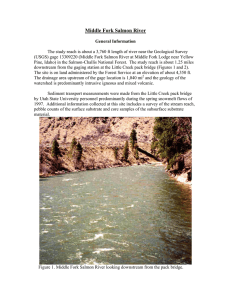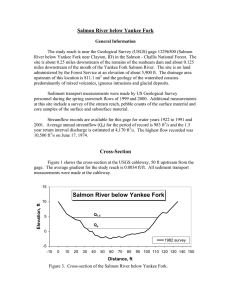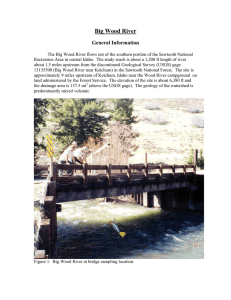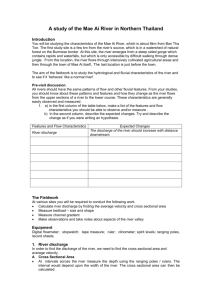Salmon River near Shoup, Idaho
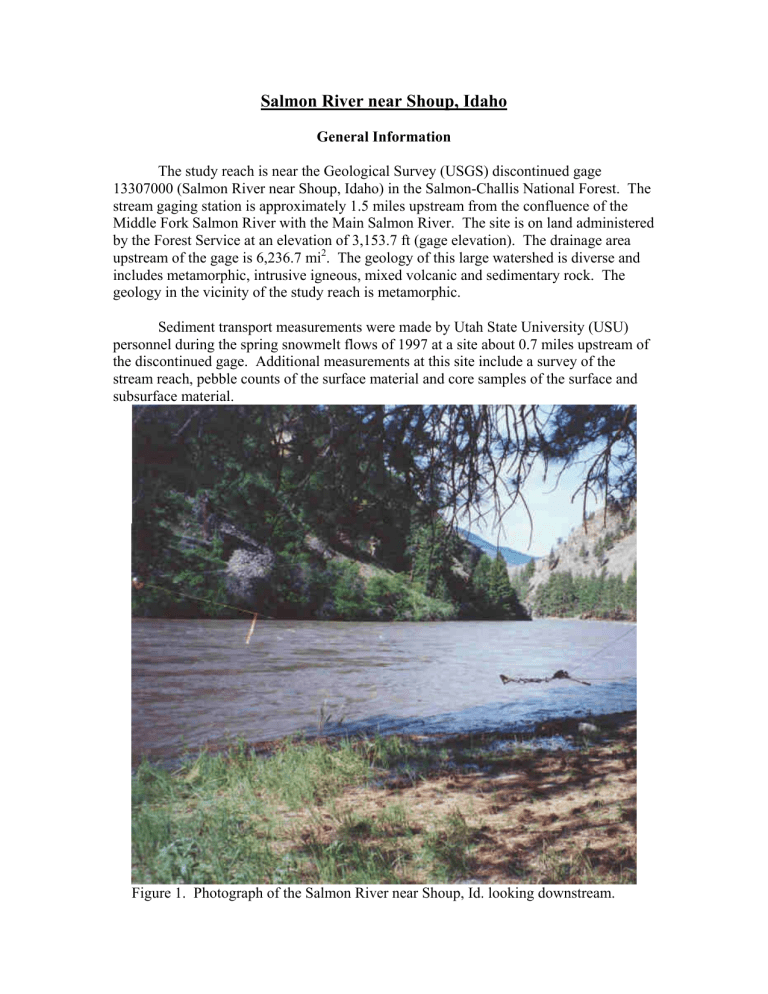
Salmon River near Shoup, Idaho
General Information
The study reach is near the Geological Survey (USGS) discontinued gage
13307000 (Salmon River near Shoup, Idaho) in the Salmon-Challis National Forest. The stream gaging station is approximately 1.5 miles upstream from the confluence of the
Middle Fork Salmon River with the Main Salmon River. The site is on land administered by the Forest Service at an elevation of 3,153.7 ft (gage elevation). The drainage area upstream of the gage is 6,236.7 mi 2 . The geology of this large watershed is diverse and includes metamorphic, intrusive igneous, mixed volcanic and sedimentary rock. The geology in the vicinity of the study reach is metamorphic.
Sediment transport measurements were made by Utah State University (USU) personnel during the spring snowmelt flows of 1997 at a site about 0.7 miles upstream of the discontinued gage. Additional measurements at this site include a survey of the stream reach, pebble counts of the surface material and core samples of the surface and subsurface material.
Figure 1. Photograph of the Salmon River near Shoup, Id. looking downstream.
Streamflow was recorded at the USGS gage site for water years 1944 to 1982.
Average annual streamflow (Q a
25,700 ft 3 /s on June 18, 1974.
) for the period of record is 3,040 ft return period discharge is estimated at 11,500 ft 3
3 /s and the 1.5 year
/s. The highest flow recorded was
Cross-Section
Figure 2 shows the cross-section at the USU gage site, upstream of the discontinued USGS gage. The average gradient for the study reach is 0.0019 ft/ft.
115
105
95
Salmon River near Shoup
85 Q a
75
1997 survey
65
-50 0 50 100 150
Distance, ft
200 250 300 350
Figure 2. Cross-section of the Salmon River near Shoup, ID at the USU gage site.
Channel Geometry
The station geometry relationships for the cross-section at the USU gage are shown in Figure 3. All information for 1997 were used to develop the power relationships with discharge. Over the range of discharges when sediment transport was measured (3,830 to 19,100 ft 3 /s) estimated stream width, estimated average depth and estimated average velocity varied from 242.3 to 299.2 ft, 3.56 to 7.82 ft, and 4.4 to 8.2 ft/s, respectively. The average reach slope is 0.0019 ft/ft.
1000 100
Salmon River near Shoup
100
Top Width y = 82.088x
0.131
R
2
= 0.52
Average Velocity y = 0.195x
0.379
R
2
= 0.78
10
10
Average Depth y = 0.062x
0.490
R
2
= 0.82
1
1000 10000
Discharge, ft 3 /s
1
100000
Figure 3. Width, average depth, and average velocity versus stream
discharge at the USU gage cross-section on the Salmon River.
Channel Material
Pebble counts were made in August 2000 at three cross-sections and three cores of surface and subsurface material were collected, one at each cross-section. The D
50
and
D
90
for the combined pebble counts wer 96 mm and 203 mm, respectively (Figure 4). It should be noted that due to the depth of the river, pebble counts did not include the entire channel width. The D
50
and D
90
for the combined subsurface cores are 28 mm and 164 mm, respectively, and for the combined surface cores are 150 mm and 207 mm, respectively.
100
Salmon River near Shoup
90
60
50
80
70
40
30
20
10
2000 Pebble Counts
2000 Subsurface Cores
2000 Surface Cores
0
0.1
1 10
Particle Size, mm
100 1000
Figure 4 . Particle size distribution for surface and subsurface material samples
in the Salmon River near Shoup, ID reach.
Sediment Transport
The bedload and suspended load measurements in water year 1997 were all made from a boat. The sediment transport data includes 61 measurements of bedload transport and 21 measurements of suspended sediment. Sediment transport measurements spanned a range of stream discharges from 3,830 ft 3 /s (1.26Q
a
) to 19,100 ft 3 /s (6.28Q
a
). Bedload transport ranged from 4.18 to 4,330 t/d and suspended transport ranged from 1,920 to
159,000 t/d. Over the range of measured discharges, suspended transport accounts for the majority of the material in transport with over an order of magnitude greater suspended transport (Figure 5).
1000000
Salmon River near Shoup
100000
10000
1000
100
Suspended y = 1.283E-09x
3.088
R
2
= 0.46
BCF=1.590
10
Total Bedload y = 2.579E-14x
3.884
R
2
= 0.71
BCF=1.350
1
Suspended
Total Bedload
Q a
Q
1.5
0.1
100 1000
Discharge, ft 3 /s
10000 100000
Figure 5. B edload and suspended load transport rate versus discharge.
Most of the bedload measurements in the high water year of 1997 were made at discharges greater than the 1.5 year return period discharge (11,500 ft 3 /s). For many of these samples the largest transport rates were associated with material larger than 8 mm diameter (Figure 6). For the eight samples collected at discharges less than 11,500 ft 3 /s, there was no material >32mm diameter in the samples and the largest transport rates were typically associated with material <0.5 mm diameter.
10000
Salmon River near Shoup
1000
<0.5mm
y = 9.295E-09x
2.323
R
2
= 0.78
100
0.5-2mm y = 4.675E-13x
3.408
R
2
= 0.83
10
2-8mm y = 3.026E-18x
4.605
R
2
= 0.67
1
0.1
<0.5mm
0.5-2mm
2-8mm
8-32mm
>32mm Q a
Q
1.5
8-32mm y = 4.898-22x
5.581
R
2
= 0.49
>32mm y = 2.225E-15x
4.013
R
2
= 0.27
0.01
1000 10000 100000
Discharge, ft
3/ s
Figure 6. Bedload transport rate versus discha rge for selected size classes.
The largest particle in the bedload sample increased with discharge (Figure 7).
The largest particle measured in a bedload sample was 78 mm at a discharge of 19,100 ft 3 /s. At discharges larger than the 1.5 year return interval discharge, the median diameter of the bedload sample increases dramatically with increasing discharge. The largest median diameter of a bedload sample was 48.5 mm at a discharge of 12,500 ft 3 /s.
The relationship between discharge and the largest particle in the bedload sample suggests that some material about the median size of the surface material is in motion at discharges near or slightly larger than the 1.5 year return interval discharge.
1000
Salmon River near Shoup
100
D
50
for three surface pebble counts
D
50
for three subsurface cores
10
R 2 = 0.72
R 2 = 0.25
1
Median Size
Largest Particle
Q a
Q
1.5
0.1
100 1000 10000 100000
Discharge, ft 3 /s
Figure 7. Largest particle in the bedload sample and median size of th e sample
versus stream discharge for the Salmon River near Shoup, ID.
